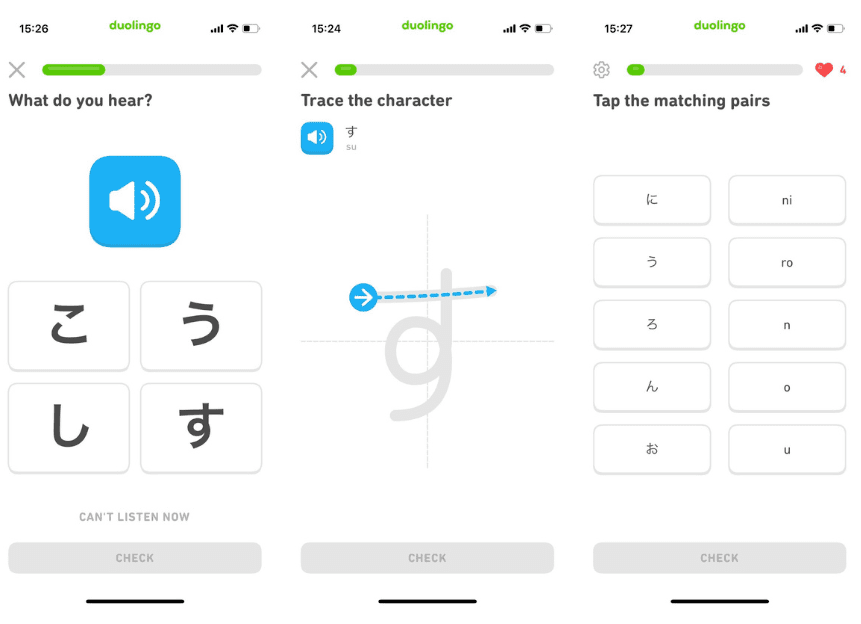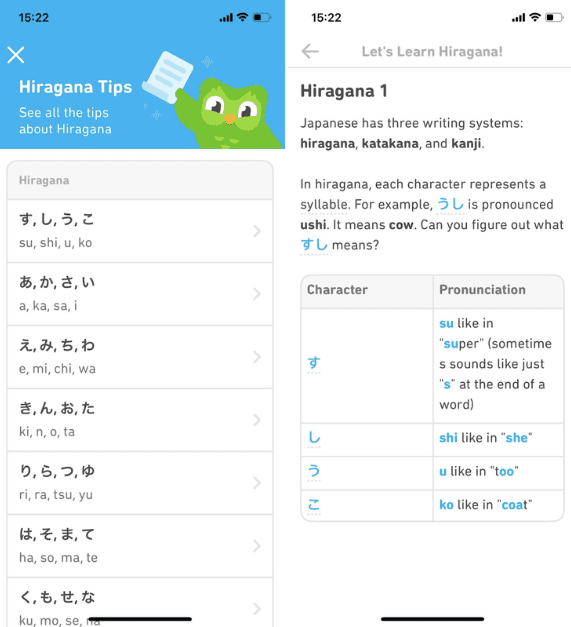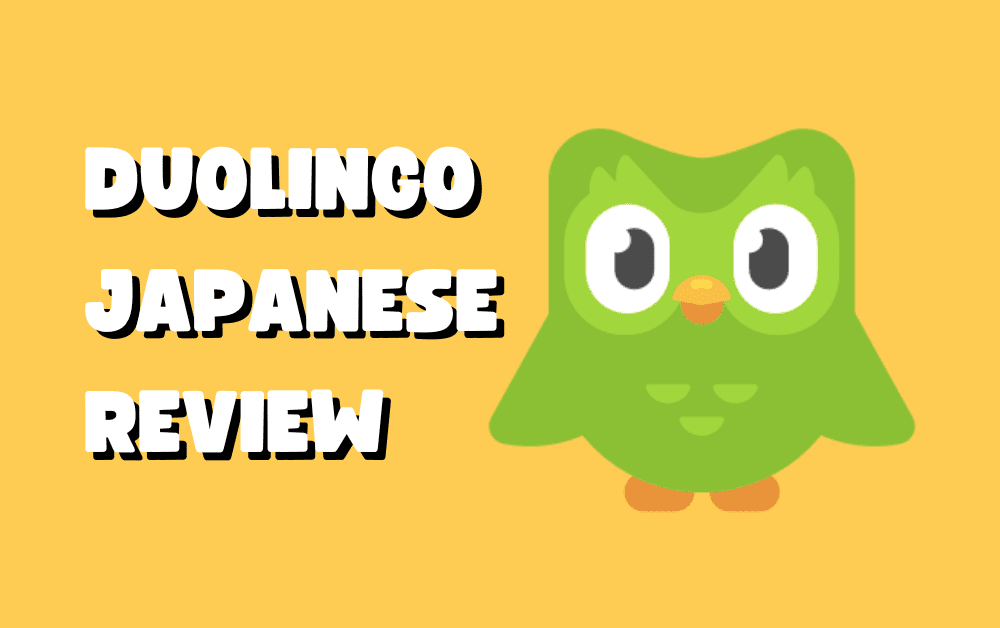Duolingo is the go-to app for many language learners. Whether you’re a polyglot, an enthusiast or a dabbler, Duolingo promises fun-filled and effective language teaching. Their platform, as championed by their famous green owl, may be super-well known but does it actually work? Especially when it comes to a language like Japanese?
A key pillar of learning Japanese and, unfortunately, often the biggest pain for beginners is ひらがな (hiragana), the most basic script or alphabet. Simply getting your head around all these unfamiliar shapes and lines can be difficult, let alone learning and recognizing them. So when Duolingo offers an easy way to master hiragana, why wouldn’t you take them up on it? We’ll break down the ins and outs of learning hiragana with Duolingo so you can decide whether it’s the app for you. Here is our our in-depth Duolingo Japanese review.
Jump to:
- What is Duolingo?
- How Does Duolingo Teach Japanese?
- Duolingo’s Key Feature
- Is Duolingo a Great App to Learn Japanese?
- Pros and Cons of Duolingo for learning Japanese
- Alternatives to Japanese Duolingo
- Duolingo & Hiragana: Final Review
What is Duolingo?
If you’ve never heard of Duolingo before, don’t worry. Here’s a quick introduction to the app: Duolingo is a language-learning app (available on mobile and web) that offers users over 40 language courses. They call themselves ‘the worlds #1 way to learn a language’, guiding learners through grammar, vocabulary, pronunciation and listening practice in quick repetitive lessons that are packaged in approachable and bite-sized games.
Looking for Japanese language learning app? Check out out: Best Apps to Learn Japanese in 2023 – Teacher’s Choice
Is Duolingo free?
Duolingo is free to download and use. The only catch is that you only get 5 ‘hearts’ a day which will limit your language-learning time on the app. Lose 5 hearts and you’re out until your hearts restore (it typically takes 5 hours to restore 1 heart).
You can stick to the free plan if you want to. Although the app will invite you frequently to try Super Duolingo which is their premium tier. Super Duolingo provides an ad-free experience and gives you unlimited hearts.
Is Duolingo only for beginners?
Definitely not! Duolingo caters to all levels of language learners. If you have studied at school or have completed some self-study, you can take a placement test to ensure you start at the right point.
How Does Duolingo Teach Japanese?
Duolingo approaches language learning in bite-sized sections that are organized by theme (think standard greetings, restaurant and airport). Duolingo visualizes your progress as a ‘path’ that you progress along.
According to their website, their methodology is research-proven to encourage longterm retention rather than short-term recall. And, to their credit, an independent study found that 34 hours of Duolingo are the same as a full university semester studying a language.
Practical learning
Since Duolingo is geared towards ‘real-life’ use cases, you’ll pick up practical constructions and vocabulary rather than in-depth grammatical understanding.
In fact, this lack of thorough grammatical learning is on purpose. Duolingo opts for what is known as ‘implicit learning’, which encourages you to organically identify patterns in language rather than rote-learning rules from a textbook.
Repetition & Recall
Duolingo uses different formatted questions to help you with vocabulary acquisition and recall. In order to ensure you pick things up properly, you’ll notice that it often repeats the same questions until you get them all right.
This is a bit similar to Anki, which is another free, open-source flashcard app that uses spaced repetition system (SRS). Its unique learning method makes it a great tool to memorize new Japanese vocabulary. But if you are a visual learner who needs engaging graphics to learn and likes to study on the phone, Duolingo offers a way better user experience.
Duolingo hearts
As we mentioned earlier, free users get 5 hearts per day. Duolingo says that hearts are key to balancing the pace of their lessons, but they’re also a big reason that Duolingo users upgrade to the premium version. Since you lose hearts by getting answers wrong, this feature can be quite frustrating for new learners who want to advance quickly.
Duolingo Japanese’s Key Features
Bite-sized Lessons
Using Duolingo, you’ll learn in bite-sized lessons. This makes the app perfect for pocket-sized studying – when you’re commuting to and from work, for example. If you want to properly dedicate yourself to studying, you’ll probably advance quickly through Duolingo’s levels – as long as you don’t lose too many hearts.
Multi-pronged Approach
Duolingo tries to give a comprehensive language learning experience that covers vocabulary, speaking, listening, and reading practice.
AI-driven
Duolingo harnesses AI algorithms to offer users a personalized learning experience. Through machine learning, the app is able to curate the pace and learning material it offers you in line with your individual level.
Is Duolingo a Great App to Learn Japanese?
Now that we’ve looked at Duolingo in-depth, let’s dive into their Japanese learning program. Specifically what it’s like learning Hiragana on the app.
Hiragana on Duolingo
When you first open up your app on the ‘home’ tab, you’ll see that Hiragana is the focus of the first 2 units.
During these first four units, you’ll learn to recognize all the characters in isolation and in words. There’s a lot of matching hiragana letters with their English pronunciation, as well as multiple-choice questions.

Hiragana & Katakana Tab
If you head to the tab marked with a ’あ’ at the bottom of your screen, you’l find yourself in Duolingo’s dedicated Hiragana and Katakana section.
This section is designed to supplement Duolingo’s standard Japanese content with a focus on helping you learn to read. Here you’ll find exercises in which you trace, spell and read all the various characters.
The app will automatically keep track of which characters you’ve mastered, which you’re still learning, and which you’ve yet to encounter.
It’s important to note that Duolingo does not introduce the letters in ‘alphabetical’ order. For instance, the first set of ひらがな characters you’ll learn are す、し、う、and こ.

The learning exercises are a mix of tracing the letters, listening to how they’re pronounced, matching a character to a sound and so on. These exercises will be similar to the ones you’ll do in the normal language learning tab.
If you head to the ‘Tips’ section, you’ll find tips and tricks relating to specific sets of characters. This section gives you a more in-depth understanding of how to pronounce each character.
Pros and Cons of Duolingo for learning Japanese
Now that we’ve taken a look at how learning hiragana with Duolingo looks, let’s recap the main pros and cons of using the app:
Advantages of Duolingo
It’s a Free Learning App
Duolingo is undeniably a great free language-learning resource. For language learners on a budget, it’s a really accessible and convenient way to learn.
It’s Convenient
In addition to being budget-friendly, the fact that you can pull out your phone whenever you have a spare minute is extremely convenient.
Easy to use
Designed to be accessible and approachable, Duolingo is really easy to use. There’s nothing intimidating about language-learning on Duolingo.
Multi-dimensional
Duolingo doesn’t take a one-dimensional approach to language-learning. Since it does cover the key pillars of listening, speaking, reading and vocabulary-building, it does offer a fairly comprehensive course of study.
Fun
The fact that Duolingo makes language-learning game-like, shouldn’t be overlooked. Though this might not be everyone’s definition of ‘fun’, it definitely helps to make studying more enjoyable.
It builds a learning habit
Duolingo also incentivizes consistent studying by encouraging users to continue their ‘streaks’. You’ll get a notification if you haven’t completed your studying for the day and get rewarded for long-time streaks. This is great for helping you to cultivate a healthy language-study habit. A duolingo employee supposedly has maintained a 3,000 day streak – now that’s impressive.
Disadvantages of Duolingo
Native English speaker-oriented
Since Duolingo is a US company, it’s not surprising that currently most of their content is geared towards native-English speakers. This is a little annoying for non-native English speakers looking to learn Japanese – though you might enjoy the added challenge.
Note that Japanese is available for English and Chinese speakers on Duolingo.
Not as suitable for advanced learners
Though Duolingo says that it can cater to all different levels of learners, we think it’s best for beginners. Advanced learners may benefit from the vocabulary building aspect of the app, but will notice the absence of proper grammatical teaching and speaking practice. If you want N2 or N1-level learning materials, we recommend checking out our list of JLPT N2 textbooks for advanced learners.
No in-depth grammatical study
If you want to learn Japanese properly, you’ll need to understand the core grammatical frameworks. This is something that Duolingo touches on, but it doesn’t really go far enough by any means.
Lacks speaking practice
Finally, though Duolingo does give you the opportunity to read out sentences in your target language, this is not really the same as conversing with a native speaker.
Duolingo Alternatives to Learn Japanese
Though Duolingo definitely has its merits, it is by no means the only option out there for Japanese language learners. Here are a few alternatives to consider:
1. Japanese Language School
At the end of the day, mobile apps can’t replace full-immersionc ourses at a dedicated language school like Coto Academy. Whether you attend private, group or online classes you’re sure to see a well-rounded level of improvement that will stick with you for the long-run. Kick start your Japanese learning journey and check out what we’ve got on offer!
2. NHK News Easy
NHK News Easy is a great language learning resource for anyone looking to practice their hiragana (and katakana) reading and comprehension skills. Run by Japan’s national news service, this website simplifies real news articles into accessible Japanese. This is a nice way to engage with real world affairs even if you’re still at a basic level of Japanese.
Check out 5 other websites that helps simplify Japanese news.
3. Memrise
Memrise is a mobile and browser-based app with a whole range of language learning courses, including Japanese. Compared to Duolingo, Memrise is weighted towards vocabulary learning. A huge plus for non-native English speakers is that Memrise offers Japanese in other languages too.
4. Picture Books or Ehon
Japanese picture books, or ehon (絵本), are great tools for kids to learn Japanese. They’re packed with the right balance of cute graphics, dialogues, Japanese sentences and an entertaining storyline. Many Japanese picture books might be perfect if you are a beginner-level Japanese learner too, because the texts uses simplified Japanese. The story can also teach you about Japanese culture and become a backdoor to understanding how Japanese society works.
5. Good old-fashioned text book
Apps haven’t replaced text-books just yet. And when it comes to learning the basics, especially hiragana, a text book might be just what you need! Many textbooks include audio files or a CD so you can hone your pronunciation alongside copying out all the characters.
Duolingo & Hiragana: Final Review
And that brings us to the end of our tour of Duolingo. At the end of the day, we can’t fault the app for its user-friendly and fun features. Its content is slightly rudimentary on some levels, but that’s fine for true beginners. In terms of learning hiragana, the app will probably provide you with a good foundation if you’re able to dedicate time and effort to doing its exercises consistently. And, since it’s free to use, we really can’t fault it as an accessible Japanese language learning resource.
Download Duolingo from the App Store and Google Play.
